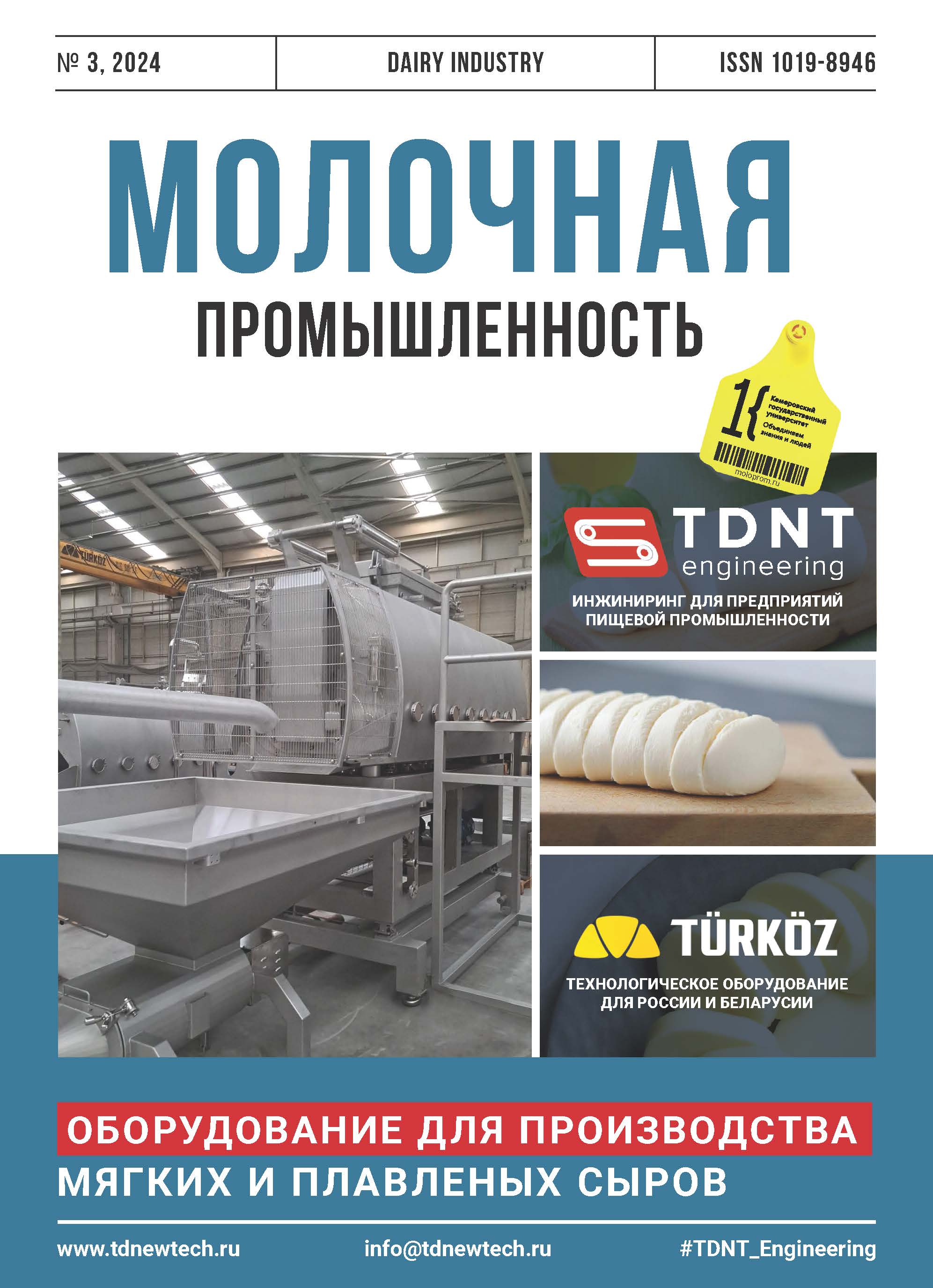Uglich, Russian Federation
Uglich, Russian Federation
Uglich, Russian Federation
Uglich, Russian Federation
The article describes the taste, smell, consistency, active acidity, penetration tension, and functional properties of products modeled on the basis of proteincarbohydrate raw materials, i.e., casein and modified starch, produced by the thermal technical processing. The physicochemical assessment involved standard methods. The list of functional properties to be tested included grating and shredding, melting, blistering, browning, and elasticity. The specialized pizza cheese rating scale was developed at the All-Russian Scientific Resarch Institute of Butter- and Cheesemaking. The taste of the product depended on the casein and starch ratio. In addition, the consistency and pH of the finished product depended on the type of modified starch and the concentration of the emulsifying salt. The research revealed a correlation between the penetration tension and raw material composition, moisture mass fraction, and emulsifying salt. The regression analysis made it possible to obtain equations for the effect of composition on melting and elasticity. The optimal ratio of raw materials resulted in a product that was close to preheated cheeses in many indicators: 25.8 % rennet casein, 18.3 % modified starch BL 240 with protein and carbohydrate ratio of 58.5/41.5, 1.0 % emulsifying salt, and 54.9% water, which provided 60.0 ± 2.0 % moisture content in the finished product.
functional properties, pizza, casein, starch, sensory properties, rating scale, regression analysis
1. Svistun, N. Kompaundy dlya imitacionnyh syrov / N. Svistun // Molochnaya promyshlennost'. 2012. № 8. S. 78–79. https://elibrary.ru/pbickn
2. Shishkina, A. N. Issledovanie funkcional'nyh svoystv termizirovannyh syrov, vyrabotannyh iz zamorozhennogo syra-syr'ya / A. N. Shishkina // Pischevye sistemy. 2021. № 4 (3S). S. 304–308. https://doi.org/10.21323/2618-9771-2021-4-3S-304-308; https://elibrary.ru/omjjeb
3. Dunaev, A. V. Imitacionnye plavlenye syrnye produkty i voprosy importozamescheniya / A. V. Dunaev // Syrodelie i maslodelie. 2017. № 4, S. 36–37. https://elibrary.ru/zpsbuz
4. Zozulin, O. Voprosy proizvodstva imitacionnyh syrnyh produktov / O. Zozulin // Pererabotka moloka. 2018. № 9. S. 34–35. https://elibrary.ru/yvlvvr
5. Al'ternativnye klassicheskomu syru produkty: ekonomichnoe proizvodstvo i raznoobrazie vkusov // Syrodelie i maslodelie. 2017. № 4. S. 40. https://elibrary.ru/zpsbvt
6. Agarwal, S. Innovative uses of milk protein concentrates in product development / S. Agarwal [et al.] // Journal of food science. 2015. Vol. 80. № S1. A23–A29. https://doi.org/10.1111/1750-3841.12807
7. Jana, A. High protein dairy foods: technological considerations / A. Jana. – Chapter in a book: Dairy Foods. Processing, Quality, and Analytical Techniques. – Woodhead Publishing, 2022. R. 159–193. https://doi.org/10.1016/B978-0-12-820478-8.00013-4
8. Dymar, O. V. Tehnologiya proizvodstva koncentrata obschego belka moloka / O. V. Dymar, E. V. Efimova, I. V. Mikluh [i dr.] // Molochnaya promyshlennost'. 2017. № 1. S. 58–60. https://elibrary.ru/xwoivl
9. Garba, U. Protein isolates: Production, functional properties and application // U. Garba, S. Kaur // International journal of current research and review. 2014. Vol. 6. № 3. R. 35–45.
10. Volodin, D. N. Perspektivy proizvodstva suhih belkovyh ingredientov na osnove molochnogo syr'ya / D. N. Volodin, A. S. Gridin, I. A. Evdokimov // Molochnaya promyshlennost'. 2020. № 1. S. 28–30. https://elibrary.ru/ygtheu
11. Meganaharshini, M. Review on recent trends in the application of protein concentrates and isolates–a food industry perspective / M. Meganaharshini [et al.] // Food and Humanity. 2023. № 1. R. 308–325. https://doi.org/10.1016/j.foohum.2023.05.022
12. Shakeel-Ur-Rehman. Use of dry milk protein concentrate in pizza cheese manufactured by culture or direct acidification / Shakeel-Ur-Rehman, N. Y. Farkye,B. Yim // Journal of dairy science. 2003. Vol. 86 № 12. R. 3841–3848. https://doi.org/10.3168/jds.S0022-0302(03)73991-5
13. Svanborg, S. The composition and functional properties of whey protein concentrates produced from buttermilk are comparable with those of whey protein concentrates produced from skimmed milk / S. Svanborg [et al.] // Journal of Dairy Science. 2015. Vol. 98. № 9. R. 5829–5840. https://doi.org/10.3168/jds.2014-9039
14. Jeewanthi, C. R. K. Characteristics of whey proteinhydrolysates from cheese whey, favors onvarious food applications / C. R. K. Jeewanthi [et al.] // Chemical Industry and Chemical Engineering Quarterly. 2014. Vol. 20. № 4. R. 503–509. https://doi.org/10.2298/CICEQ130221032J
15. Dhanraj, P. Influence of using a blend of rennet casein and whey protein concentrate as protein source on the quality of Mozzarella cheese analogue / P. Dhanraj [et al.] // Journal of Food Science and Technology. 2017. № 54. R. 822–831. https://doi.org/10.1007/s13197-017-2528-5
16. Sviridenko, G. M. Syry dlya piccy. Neobhodimost' podbora syr'ya dlya obespecheniya bezopasnosti i funkcional'nyh svoystv produkta / G. M. Sviridenko, V. V. Kalabushkin // Syrodelie i maslodelie. 2019. № 5. S. 10–12. https://elibrary.ru/jvcizz
17. Chavan, R. S. Cheese substitutes: An alternative to natural cheese - A review / R. S. Chavan, A. Jana // International Journal of Food Science, Technology & Nutrition. 2007. № 2. R. 25–39.
18. Pérez-Pacheco, E. Isolation and characterization of starch obtained from Brosimum alicastrum Swarts Seeds / E. Pérez-Pacheco [et al.] // Carbohydrate polymers. 2014. № 101. R. 920–927. https://doi.org/10.1016/j.carbpol.2013.10.012
19. Ashogbon, A. O. Dual modification of various starches: Synthesis, properties and applications / A. O. Ashogbon // Food chemistry. 2021. № 342. 128325. https://doi.org/10.1016/j.foodchem.2020.128325
20. Šimková, D. Effect of cultivar, location and year on total starch, amylose, phosphorus content and starch grain size of high starch potato cultivars for food and industrial processing / D. Šimková [et al.] // Food chemistry. 2013. Vol. 141. № 4. R. 3872–3880. https://doi.org/10.1016/j.foodchem.2013.06.080
21. Zhambusinova, K. V. Primenenie modificirovannyh krahmalov v pischevoy promyshlennosti / K. V. Zhambusinova // Molodezh' i nauka. 2020. № 10. 13. https://elibrary.ru/ruviko
22. Mehfooz, T. Effect of cross-linking on characteristics of succinylated and oxidized barley starch / T. Mehfooz, T. M. Ali, A. Hasnain // Journal of Food Measurement and Characterization. 2019. № 13. R. 1058–1069. https://doi.org/10.1007/s11694-018-00021-3
23. Diamantino, V. R. Starch as a potential fat replacer for application in cheese: Behaviour of different starches in casein/starch mixtures and in the casein matrix / V. R. Diamantino [et al.] // International dairy journal. 2019. № 89. R. 129–138. https://doi.org/10.1016/j.idairyj.2018.08.015
24. Dharaiya, C. Comparison of natural Mozzarella cheese with acid casein based Mozzarella cheese analogue / C. Dharaiya [et al.] // Indian Journal of Dairy Science. 2021. Vol. 74. № 4. R. 301–308. https://doi.org/10.33785/ijds.2021.v74i04.003
25. Abbasi, S. The Feasibility of Manufacturing Low Fat Pizza Cheese by Use of Pre-Gelatinized Corn Starch / S. Abbasi, L. Nateghi // Journal of Food Biosciences and Technology. 2022. Vol. 12. № 3. R. 51–66. https://doi.org/10.30495/jfbt.2022.19731
26. Sviridenko, G. M. Shkala ocenki syrov dlya piccy / G. M. Sviridenko, V. V. Kalabushkin, A. N. Shishkina // Syrodelie i maslodelie. 2022. № 4. S. 28–32. https://doi.org/10.31515/2073-4018-2022-4-28-32; https://elibrary.ru/fyupyp
27. Sokolova, N. Yu. Vliyanie rossiyskih soley-plaviteley na kachestvo plavlenyh syrnyh produktov / N. Yu. Sokolova // Syrodelie i maslodelie. 2010. № 5. S. 20–23. https://elibrary.ru/muvell





